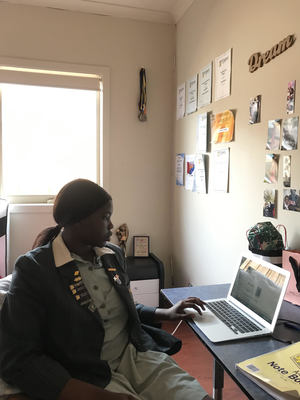In this Covid-19 world, students and schools are learning to adapt to the new solitude, say St John’s Regional College captains Tofy Jorissen and Aker Mawith.
“I miss everything about school,” Tofy says of the remote-learning experience.
From the comfort and privacy of his family home, Tofy keeps in instant touch with teachers on the app Microsoft Teams – an interactive app that could become a “permanent” part of learning, he says.
“Teachers are able to help out kids when we are in trouble and do respond to our questions almost instantly, which is good.”
On the negative side, Tofy worries about being unable to submit work if his home internet drops out.
Of course, a big change is being estranged from friends – except through social media.
“I have my family and friends to motivate me to do my work – my goal is still the same, I’m just getting there through a different path.”
Meanwhile, Aker enjoys the increased flexibility and adapting to new technology. But she also misses social interaction and one-to-one teaching.
There’s also an “intense requirement for self-discipline and self-direction”.
“I’ve got motivational quotes that pop up on screen as soon as my alarm rings and consistently through the day to give me a boost and direction.
“Being positive is key, aim for balance, and visualize the outcome.
“Our teachers at St John’s are really putting so much effort into helping all their students especially through this tough time, but it’s up to us to grab it.”
Daily reminders are also set for video-chat classes – in which she interacts with her ‘classmates’.
“I think social apps like Zoom and Teams should be a key part to learning, because it does not only encourage students to interact but it can also boost a level of confidence socially.
“Emailing is not always the best way – especially in this generation, children seek more attention and interaction with one another and hearing someone say something.”
Teachers had also initially found it “very difficult to get our heads around” working from home, St John’s teacher and ICT learning systems leader Maria Nasioulas said.
“During these unprecedented times, the solitude of teaching and learning took us by surprise as our workplace is a busy and active one – routines, timetables and running around to rooms to teach our students.”
She appreciates not travelling to work and the “comforts of home” but misses not being able to interact with students and colleagues, including the “joy of seeing kids learn”.
The school had invested in an online learning management system SEQTA, which helped teachers to effectively apply remote learning, Ms Nasioulas said.
After the pandemic, she expected the continuation of real-time feedback to parents, the use of engaging software, and data-driven learning programs to target students.
Principal Tim Hogan said teachers would become better teachers as a result of the experience.
“One huge positive for us is we need to listen really closely to our student voice… to what students are seeking with the learning environment.”
It also underlined that students learn in different ways. Some were thriving at home due to being able to focus better and take “ownership” of their learning, while others struggled in solitude.
Mr Hogan acknowledged a “stress that doesn’t disappear” during the pandemic. Working remotely meant that home was no longer your “break from work”.
“You feel like you’re always on.
“That’s why people aren’t sleeping well across the board.
“You finish your day and it’s in your face in terms of the news. It’s difficult to leave it all behind and take a break from it.”
Mr Hogan said the school was pushing to keep people connected – such as prompting students to regularly say ‘hello’ via social media.
Nevertheless, the simple need for companionship couldn’t be replaced.
“People don’t realise how important a community is until it’s gone.”









